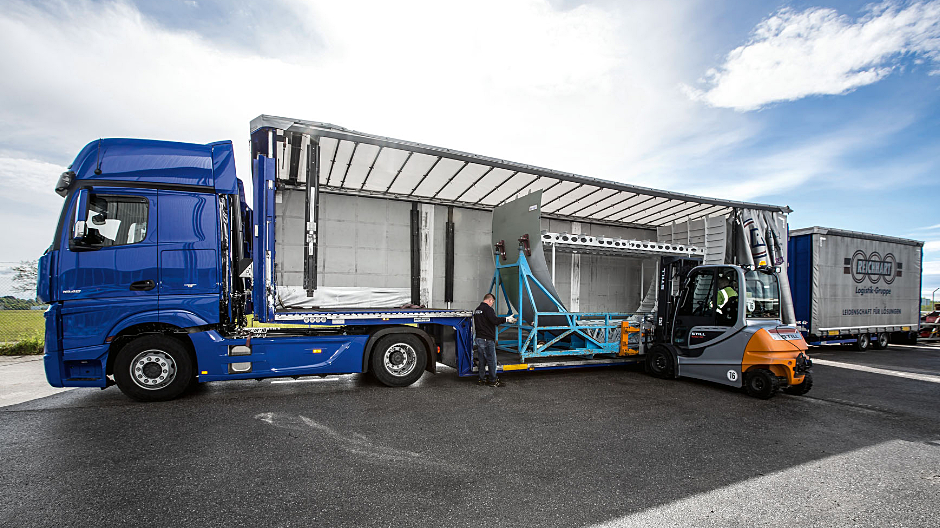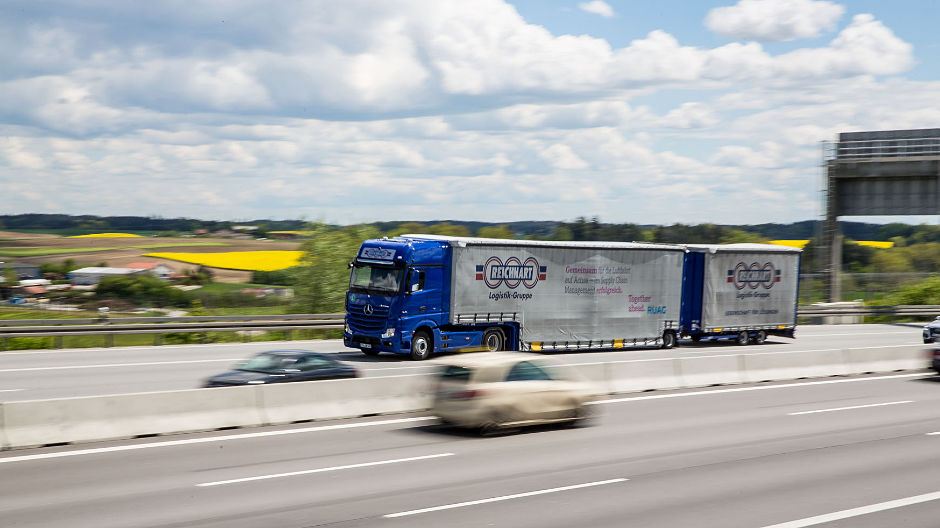
Reichhart Logistik transports freight in special trucks
Economics & Logistics
At RUAG in Gilching, Reichhart Logistik uses a long version of the Actros to ensure the smooth supply of aircraft components to Airbus. The logistics company's scope of services ranges from packaging to IT-supported timing of deliveries using their own software.

This sight is like something out of a childhood dream. Aircraft tails are neatly aligned in the bright hall. The components still bear their light-green primed aluminium skin with fresh rivets. But it isn't model aeroplane parts that are lined up in the production hall of RUAG Aerostructures in Gilching near Munich: these are tailcones for the real Airbus A320. Known on the A320 assembly plans simply as "section 19.1", these components will be needed in 36 hours' time at the Airbus plant in Finkenwerder near Hamburg.
The production lines of supplier RUAG and the final assembly at Airbus are separated by 800 kilometres, so there is no room for error when it comes to stock replenishment. "In aircraft manufacturing, production occurs 'just-in-time', as it does in the automotive industry. There is a co-ordinated process and production chain which sees the implementation of very tight time frames for deliveries. And if parts are missing, the production line has to be stopped. With such high production costs as these, that cannot happen," says Georg Berberich, Executive Manager of Reichhart just in time GmbH, a subsidiary of Reichhart Logistik GmbH based in Gilching. The 38-year-old is very familiar with the processes involved in aircraft manufacturing; in fact, he probably knows them just as well as the employees at Airbus and RUAG themselves. He has to, because Reichhart is the transport and contractual logistics partner which forms the missing link between the two distant production locations.
In Gilching, the teams from Reichhart and RUAG work hand-in-hand. Their long-term partnership has become a perfectly intertwined symbiosis between a manufacturer and haulier. As part of the production process, Reichhart is also responsible for works-internal transport of the aircraft components to the paint shop. Once the assembly of the sections if complete, Reichhart's team takes over and affixes them to their own in-house-developed transport frames before covering them with a scuff-preventing wrap.
In front of the hall, a long version of the Actros 1848 truck awaits its freight. As aircraft components are light but sizeable, a low loader with a total load height of 3.70 metres is used for their transport. If components such as the fuselage section 18/19 – also produced in Gilching– are to be transported, this occurs as special transport with a 4.38-metre load height. The transport frames are then loaded onto mushroom-shaped fixing points in the floor of the semitrailer and then securely bolted in place. With just a single stop, the Reichhart special trucks draw near to Hamburg where the fuselage segment is to be handed over to the Airbus team in a time slot between 10 p.m. and 5 a.m.

The trucks Reichhart uses to transport various aircraft components from Munich to Hamburg are 25 metres long.
"We provide our customers with company-internal support, packaging, shipping and even supply chain and transport control. It's a complete package which we wish to continue optimising for them," explains Berberich.
One of these optimisations is the use of long trucks: "On average, we drive the Airbus route ten times a week. Without the long truck, we'd need another five journeys per week."
Reichhart Logistik GmbH was founded in 1967 and today employs more than 900 people. Several competence centres offer further complex contract logistics solutions similar to that of RUAG. "We deliver exhaust systems to the BMW Group plants in Munich on behalf of one of their suppliers. As the assembled systems take up lots of space in trucks, we initially transport individual components to one of our Munich locations where our robots weld them together and sequentially add them into BMW's production processes," says Berberich. Reichhart often also provides services directly at the premises of their customers.
In order to control the sometimes highly complex logistics chains, the company founded Reichhart digital logistics GmbH – their own IT subsidiary which, since 2014, has been delivering customer-specific hardware and software solutions for programming, optimising and maintaining supply chains. "We firmly believe that sooner or later, only appropriate contractual logistics services will be offered, whereby the providers have their own IT competence. Under logistics 4.0, that will be unavoidable," affirms Berberich. For the logistics concept of the future, as part of which both the goods and the logistics processes of manufacturers, haulage firms and customers are seamlessly digitally connected with one another, Reichhart is already in a good stance.
Even in terms of the fleet structure, Reichhart continues to make optimisations. "The vast majority of our 72 company-owned tractor units are Mercedes trucks and are as well-equipped as possible. Besides all of the available safety systems, we also target wear and consumption minimisation, looking in particular at the implementation of the retarder and tyre pressure monitoring," says Berberich. Here, the company makes use of the telematics-assisted systems FleetBoard and Predictive Powertrain Control.
Mercedes-Benz Uptime is also in operation at the company since the beginning of the year. This further increases vehicle usability by identifying potential malfunctions in good time using the telematics systems and subsequently forwarding appropriate information to Reichhart's fleet management team. Particularly in the case of tours subject to specific approvals from the authorities, such as those driven for RUAG, whereby the tractor unit can't simply be swapped for another one, this will be a decisive advantage in the future. "Mercedes-Benz Uptime was the next logical step in vehicle data use for us."
Berberich tells us that the company's first experiences with the system have been impressive: "Before the driver was even able to identify and tell us about damage to a radiator line, the service team from the Customer Assistance Center was already on the phone: 'We've detected that vehicle A has a problem with its B. We could...' This allows us to ensure we operate stable delivery tours from RUAG to Airbus."
Photos: Enno Kapitza




Comment
Please log in to post a comment.
2 comments